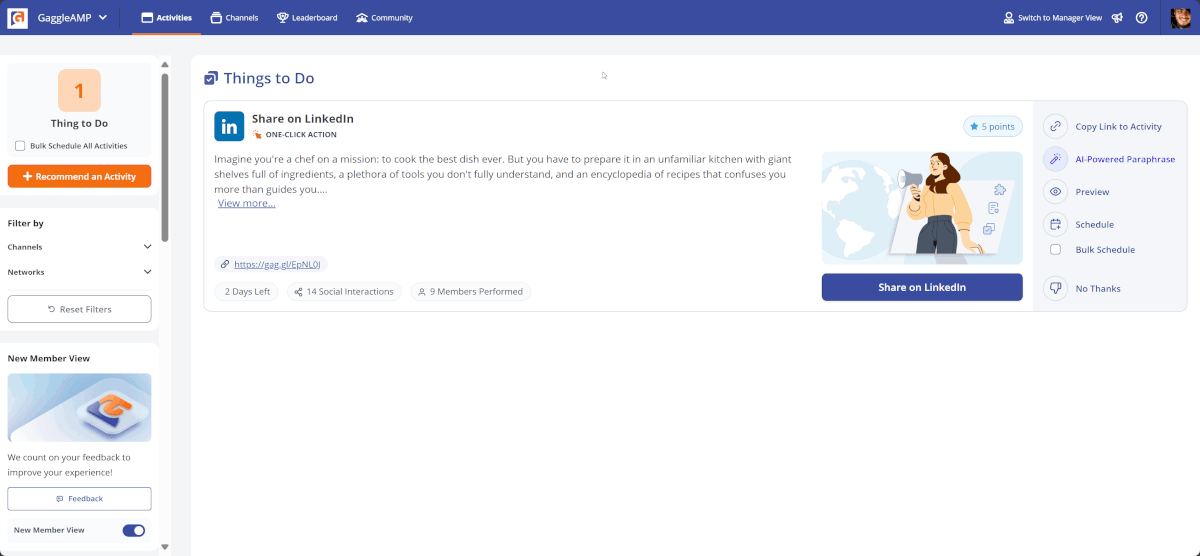The Only Social Media Marketing Template You’ll Ever Need
Creating a strategy for your social media marketing efforts doesn’t have to be difficult even if you’re newer to the game. All you need is a social media marketing template to help you organize your ideas and create a plan.
There are plenty of templates you’ll find online and most of them do a decent job - yes, we checked. But, if we’re being honest, they either focus just on creating a standard strategy or only offer a template without any explanation. You can’t really get anywhere if you don’t where you’re going and how you are traveling, can you?
In order to build a plan that drives results, you don’t just need a template — you also need a solid social media marketing strategy to guide it. This guide bridges both, offering structure and direction in one place. In this article, I’m going to show you the most important points in creating social media campaigns while giving you a ready-to-use, actionable template at the same time.
Now let’s dig in.
1. Know Your Main Goal
The first step in creating a social strategy is to define your social media goals. What do you hope to achieve with your social media marketing campaigns? Is it increase your social media presence? Better engagement from your audience? Build thought leadership?
Have in mind that achieving that goal is a process - not a one-time thing - and the techniques for achieving it will change along the way. Sometimes you’ll have to change the plan because of internal, and sometimes because of external factors. Whatever the circumstances and reasons, never lose focus of your main outcome.
Use this social media marketing template to always have your social media goals in front of you:
2. Identify Your Audience and Customers
Who will you be marketing to? Don’t say “everyone” - I’ll bet you a cow and a handful of magic beans that “everyone” is not your ideal customer. Always target an audience that actually needs the solution you’re offering.
In order to do that, it’s best to have an ideal customer persona (i.e. a description of what that ideal customer might look like). For example:
- Are the age or gender relevant?
- Does their location matter? Does it change how you reach them?
- What problem are they trying to solve?
- Which social channel does your audience frequent?
Answer these questions (and others) and you’ll effectively reduce time spent on audience research and cut budget losses from vague marketing.
Here’s a social media marketing plan that focuses on the buyer persona that you can use to create your customer’s profile. You can add/remove as many items or questions as you wish.
3. Plan Your Budget
Before starting any campaign, it’s only logical you know the amount of budget available to you. This might depend on the company you’re working for, whether the expenses are only related to the in-house marketing team or if you plan to outsource/subcontract some external players.
Then there are the different categories of the campaign like content or selling strategy and creation, advertising through your social media networks, software, or any tools that will help you measure engagement, schedule posts, and monitor performance - and this is just the tip of the iceberg.
Use our social media budget template so you don’t get overwhelmed when all these metrics lean heavily on your shoulders:
4. Create a Social Media Content Calendar
Once you know your goals, target audience, and budget, you can begin creating content for your social media strategy template. This is where it gets serious: when it comes to social media, not all content is created equal.
It’s your job to learn what works best and double it down. And you learn that through lots of testing different types of content. Bear in mind, though, that even among your ideal audience preferences will be different - some people will appreciate better a long-form guide designed as a lesson plan that guides the reader through a complex topic. Others are more visual and would prefer infographics or video tutorials.
This is a general social media content calendar template that focuses on various types of content, but you can always customize it according to your needs or use it as a starting point for your own social media calendars:
5. Social Media Template for the Greats: Facebook, Instagram, LinkedIn
While many newer social media channels are taking the internet by storm - like TikTok or Twitch - the Holy Trinity of social media platforms: Facebook, Instagram, and LinkedIn, still hold the highest ranking in the business world.
We’re not saying that you shouldn’t experiment with the new, we’re saying never exclude the golden goose from whatever social media marketing strategy you’re crafting.
As Facebook continues to rule the internet with 2.91 billion users who prefer this platform to any other as of October 2021, Instagram keeps growing with almost 1.5 billion users by the beginning of 2022. As for LinkedIn, if 58 million companies trust it for reaching both B2B brands and consumers - well, I don’t have to convince you, do I?
Here is our social media plan template specifically designed for leveraging content on these social networks. I've even included a few mockup social media posts just to show you how it works (best used with the content calendar template from the previous section):
6. Schedule Posting and Save Time
You don’t plan to manually post on every single platform, right? Even the interns can be put to better use than wasting time clicking “publish” all day long. Instead, use a tool that can automatically do that for you.
All you have to do is arrange the days and times you want to post content and then just sit back and relax while technology does its thing. This way you don’t only save time, but you’ll also never miss a post. And the best part is, that you can schedule social media messaging, so you don’t have to worry about ideas and creativity every other day.
See how this looks in practice with our own tool:

7. Get Inspired by Other Businesses
If anyone tells you that you have to start from scratch when creating content - do not believe them. Sure, you can do it, if time and money weren’t an issue. Don’t get this wrong - never ever copy ( or steal) other people’s content and present them as your own. But, you can go and look through their content for inspiration.
Any good social media manager will tell you that it’s a good practice to keep a list of resources for inspiration. These can be your direct competitors, the top influencers in your industry, or any content that’s performing well. This way you’ll always have a swipe file of ideas you’d like to explore deeper.
This is easy to do.
-
Follow everyone relevant on the platforms you want to publish content on
-
Identify what’s working for them
-
Read the comments and offer your insight, or even a contrarian point of view, as long as it’s constructive.
You’ll get great inspiration, plus free exposure of your brand to important profiles.
Let me share our own social media template for a resource list that you’re more than welcome to copy:
8. Have a Social Media Style Guide
The style guide helps everyone involved in the social media strategy, or content strategy for that matter - including your brand advocates - to have a clear and consistent understanding of your brand’s image on social media. This can refer to small issues like grammar or punctuation, but also the important do’s and don’ts for posting in the name of the brand. You can reinforce these guidelines with a documented social media policy that outlines expected behavior across channels.
This way it’s easier to onboard new employees quickly and avoid any uncomfortable or damaging scenarios that might occur when people are not familiar with your brand’s tone, voice, and general image.
A style guide also comes in hand for technical stuff like the length of sentences or paragraphs, which social platform likes short messages, and which one prefers the longer version. Also, team members should know when it’s appropriate to use emojis in their posts and when not so much.
Steal this style guide checklist for your company and never let such minor glitches be the reason for a failed marketing strategy:
9. Track Metrics
It comes without saying that if you want a successful campaign, you need to know first what’s working and what isn’t. This will help you decide on your next steps and where you should adjust.
For example, audit where your messaging is performing best:
- What social network performs best?
- What type of content has the most engagement?
- Videos
- Bullet lists
- Links to how-to guides
- Posts that tag other creators and businesses?
- Review vanity metrics
- Number of followers
- Likes
- Shares
- Reach
This will also help you weed out any unnecessary leads like fake or outdated profiles.
You can do this by using the incorporated features of each platform, or when you share through employee advocacy programs, leave it to the pros, like GaggleAMP, which automatically tracks this performance for you. You can track anything you consider important for your marketing strategy using the template below, but these are a must for any brand:
Before You Create That “Social Media Marketing Templates” Folder
Nothing is written in stone, especially social media marketing templates. They should be updated regularly to reflect changes in your business and the social media landscape. Remember to always adjust your strategy as needed — these are simply baselines that can be customized to best address your business needs.
That said, the points I’ve listed above should be an integral part of any campaign you have or might have in the future. Consider them as a blueprint that you can always come back to when feeling stuck or in need of inspiration.
With the templates at your disposal, you can save time and produce more effective social media marketing campaigns. Combine them with effective tools and see the process speed up like never before.


















